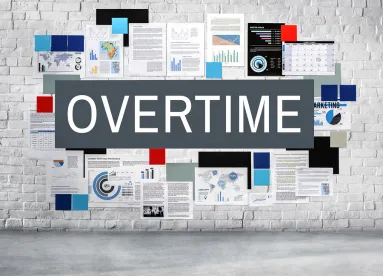The DOL’s request for public comments concerning the FLSA’s overtime exemptions regulations suggests there could be significant changes ahead on those regulations.
On July 25, the US Department of Labor (DOL) posted a “request for information” on potential revisions to the Fair Labor Standard Act’s (FLSA’s) overtime exemptions. The DOL indicated that this request would precede and inform a subsequent formal request for public comment on proposed rulemaking. Specifically, the request seeks feedback on a variety of issues related to not only the specific 2016 revisions to the FLSA overtime exemption regulations but also to potentially more expansive changes to the regulations. For example, the DOL is seeking comments on how the appropriate salary level for the overtime exemptions should be determined, and whether salary levels should be different for different exemptions or based on various factors such as size of employer or region of employment. The DOL is also seeking comments on whether separate salary or duties tests are needed or if one or the other could be sufficient to determine exemption status. The DOL also seeks information regarding the extent to which employers actually increased salaries of employees or reclassified employees in response to the 2016 regulations, presumably so that the DOL can evaluate the financial impact the regulation changes have already had on businesses. These questions indicate that the DOL continues to reconsider much of the DOL’s agenda under former US President Barack Obama, especially considering its recent withdrawal of the prior administration’s administrative interpretations concerning joint employment and contractor misclassification.
The request for information will be formally published on July 26, 2017, and the deadline to submit comments will be 60 days from that date (September 24, 2017).
Background
Prior to 2016, the FLSA overtime regulations were last updated in 2004. In March 2014, former President Obama directed the DOL to “modernize and streamline” the DOL’s white collar exemption regulations. Pursuant to President Obama’s directive and after a notice-and-comment period, the DOL issued its Final Rule on May 18, 2016, which
-
increased the minimum salary needed to qualify for the FLSA’s white collar exemptions from $455 per week to $913 per week;
-
increased the total annual salary requirement for the highly compensated exemption from $100,000 to $134,000;
-
established a mechanism to update these salary and compensation levels automatically every three years; and
-
amended the salary basis test to allow employers to use nondiscretionary bonuses and incentive payments (including commissions) to satisfy up to 10% of the new minimum salary level.
The 2016 Final Rule, however, has not gone into effect due to an order from the US District Court for the Eastern District of Texas that enjoined the implementation of the rule. The DOL appealed that injunction order and it is currently being reviewed by the US Court of Appeals for the Fifth Circuit. The pending appeal of that order concerns the reasoning of the district court that called into question the DOL’s authority to utilize a salary level test in determining the exempt status of employees under the FLSA. The Department of Justice, on behalf of the DOL, is arguing that 29 U.S.C. § 213(a)(1) provides the Secretary of Labor authority to establish a salary level test. However, the DOL has decided not to advocate for the specific salary level set in the 2016 Final Rule at this time and has stated that, instead, it intends to undertake further investigation and rulemaking regarding the salary level and potentially other changes to the FLSA overtime regulations. The shift in the DOL’s position on the 2016 Final Rule coincides with President Donald Trump’s executive order issued on February 24, 2017, which directed all federal agencies to identify regulations for repeal, replacement, or modification that, among other factors, eliminate jobs or inhibit job creation.
DOL Request for Information
In its request, the DOL notes that it is “aware of stakeholder concerns that the standard salary level set in the 2016 Final Rule was too high,” and that “stakeholders have expressed the concern that the new salary level inappropriately excludes from exemption too many workers who pass the standard duties test.” Based on these and other concerns regarding the 2016 Final Rule, the DOL seeks comments on the following questions:
-
Would updating the 2004 salary level for inflation be an appropriate basis for setting the standard salary level and, if so, what measure of inflation should be used? Alternatively, would applying the 2004 methodology to current salary data be an appropriate basis for setting the salary level? Would setting the salary level using either of these methods require changes to the standard duties test and, if so, what change(s) should be made?
-
Should the regulations contain multiple standard salary levels? If so, how should these levels be set: by size of employer, census region, census division, state, metropolitan statistical area, or some other method? For example, should the regulations set multiple salary levels using a percentage-based adjustment like that used by the federal government in the General Schedule Locality Areas to adjust for the varying costs of living across different parts of the United States? What would the impact of multiple standard salary levels be on particular regions or industries, and on employers with locations in more than one state?
-
Should the DOL set different standard salary levels for the executive, administrative, and professional exemptions as it did prior to 2004 and, if so, should there be a lower salary for executive and administrative employees, as was done from 1963 until the 2004 rulemaking? What would the impact be on employers and employees?
-
In the 2016 Final Rule the DOL discussed in detail the pre-2004 long- and short-test salary levels. To be an effective measure for determining exemption status, should the standard salary level be set within the historical range of the short-test salary level, at the long-test salary level, or between the short- and long-test salary levels, or should it be based on some other methodology? Would a standard salary level based on each of these methodologies work effectively with the standard duties test or would changes to the duties test be needed?
-
Does the standard salary level set in the 2016 Final Rule work effectively with the standard duties test or, instead, does it in effect eclipse the role of the duties test in determining exemption status? At what salary level does the duties test no longer fulfill its historical role in determining exempt status?
-
To what extent did employers, in anticipation of the 2016 Final Rule’s effective date of December 1, 2016, increase salaries of exempt employees in order to retain their exempt status, decrease newly nonexempt employees’ hours or change their implicit hourly rates so that the total amount paid would remain the same, convert worker pay from salaries to hourly wages, or make changes to workplace policies either to limit employee flexibility to work after normal work hours or to track work performed during those times? Where these or other changes occurred, what has been the impact (both economic and noneconomic) on the workplace for employers and employees? Did small businesses or other small entities encounter any unique challenges in preparing for the 2016 Final Rule’s effective date? Did employers make any additional changes, such as reverting salaries of exempt employees to their prior (pre-rule) levels, after the preliminary injunction was issued?
-
Would a test for exemption that relies solely on the duties performed by the employee without regard to the amount of salary paid by the employer be preferable to the current standard test? If so, what elements would be necessary in a duties-only test, and would examination of the amount of nonexempt work performed be required?
-
Does the salary level set in the 2016 Final Rule exclude from exemption particular occupations that have traditionally been covered by the exemption and, if so, what are those occupations? Do employees in those occupations perform more than 20% or 40% nonexempt work per week?
-
The 2016 Final Rule for the first time permitted nondiscretionary bonuses and incentive payments (including commissions) to satisfy up to 10% of the standard salary level. Is this an appropriate limit or should the regulations feature a different percentage cap? Is the amount of the standard salary level relevant in determining whether and to what extent such bonus payments should be credited?
-
Should there be multiple total annual compensation levels for the highly compensated employee exemption? If so, how should they be set: by size of employer, census region, census division, state, metropolitan statistical area, or some other method? For example, should the regulations set multiple total annual compensation levels using a percentage-based adjustment like that used by the federal government in the General Schedule Locality Areas to adjust for the varying costs of living across different parts of the United States? What would the impact of multiple total annual compensation levels be on particular regions or industries?
-
Should the standard salary level and the highly compensated employee total annual compensation level be automatically updated on a periodic basis to ensure that they remain effective, in combination with their respective duties tests, at identifying exempt employees? If so, what mechanism should be used for the automatic update; should automatic updates be delayed during periods of negative economic growth; and what should the time period be between updates to reflect long-term economic conditions?
Comment Deadline
The request for information was posted on July 25, 2017 and will be formally published in the Federal Register on July 26, 2017. Comments will be due within 60 days after the official publication of the request, which will be September 24, 2017.
Most Notable Areas of Inquiry
The DOL’s request signals that significant changes to the FLSA overtime regulations may be coming. Specifically, the questions posed by the DOL indicate that new regulations may go well beyond lowering the salary requirement mandated by the 2016 Final Rule. It appears that the DOL may also introduce broader changes to the FLSA overtime regulations. For example, the DOL’s question regarding whether a salary requirement is necessary at all suggests that the DOL is exploring a duties-only test for exemption status. Likewise, the DOL’s questions suggest that if a salary requirement remains, the salary levels may vary by exemption and/or may be set based on factors such as employer size and/or cost-of-living statistics. Another critical question, particularly in the retail and quick-serve food industries, is the DOL’s inquiry into whether the 2016 regulation changes would have eliminated the exemption for jobs that historically have been exempt. This suggests that the DOL may be reluctant to take any action that would dramatically change the longstanding playing field for employers in particular industries. It is difficult to predict how the DOL under the Trump administration will revise the current FLSA overtime exemptions, particularly without us seeing the comments that will be received, but the DOL apparently is considering the full range of options.
Employers should continue closely tracking these developments and preparing for the changes that are likely to follow the DOL’s request for information. But employers must also remain vigilant in their compliance efforts. In addition to the DOL’s actions, the plaintiffs’ bar remains as active as ever in pursuing FLSA violations.




 />i
/>i

